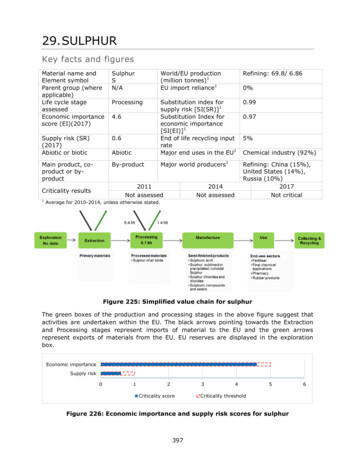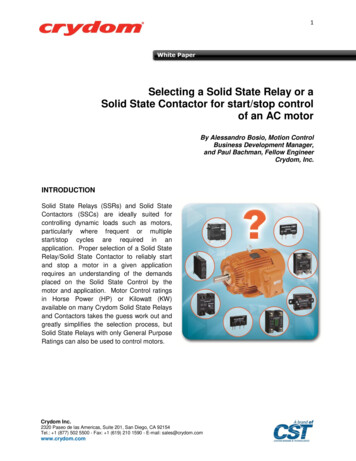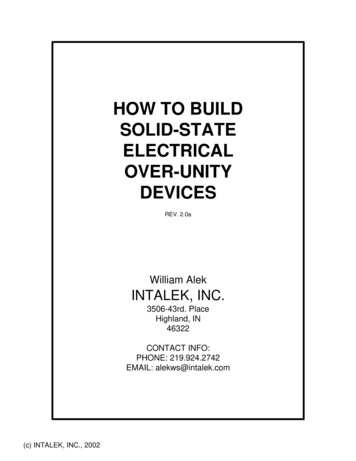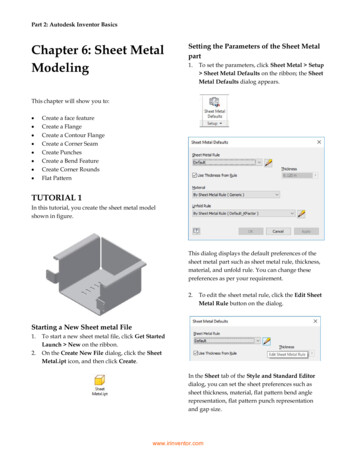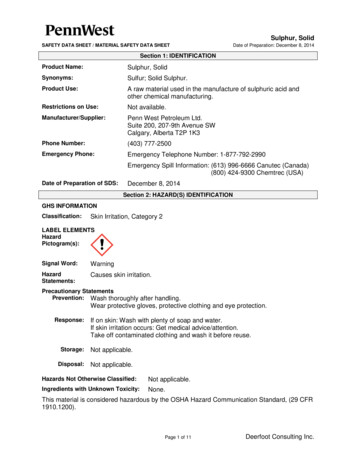
Transcription
Sulphur, SolidSAFETY DATA SHEET / MATERIAL SAFETY DATA SHEETDate of Preparation: December 8, 2014Section 1: IDENTIFICATIONProduct Name:Sulphur, SolidSynonyms:Sulfur; Solid Sulphur.Product Use:A raw material used in the manufacture of sulphuric acid andother chemical manufacturing.Restrictions on Use:Not available.Manufacturer/Supplier:Penn West Petroleum Ltd.Suite 200, 207-9th Avenue SWCalgary, Alberta T2P 1K3Phone Number:(403) 777-2500Emergency Phone:Emergency Telephone Number: 1-877-792-2990Emergency Spill Information: (613) 996-6666 Canutec (Canada)(800) 424-9300 Chemtrec (USA)Date of Preparation of SDS:December 8, 2014Section 2: HAZARD(S) IDENTIFICATIONGHS INFORMATIONClassification:Skin Irritation, Category 2LABEL ELEMENTSHazardPictogram(s):Signal Word:WarningHazardStatements:Causes skin irritation.Precautionary StatementsPrevention: Wash thoroughly after handling.Wear protective gloves, protective clothing and eye protection.Response:If on skin: Wash with plenty of soap and water.If skin irritation occurs: Get medical advice/attention.Take off contaminated clothing and wash it before reuse.Storage:Not applicable.Disposal:Not applicable.Hazards Not Otherwise Classified:Not applicable.Ingredients with Unknown Toxicity:None.This material is considered hazardous by the OSHA Hazard Communication Standard, (29 CFR1910.1200).Page 1 of 11Deerfoot Consulting Inc.
Sulphur, SolidSAFETY DATA SHEET / MATERIAL SAFETY DATA SHEETDate of Preparation: December 8, 2014Section 3: COMPOSITION / INFORMATION ON INGREDIENTSHazardous Ingredient(s)Common name /SynonymsCAS No.SulfurSulfur dioxideHydrogen sulfide (H2S)Not available.Not available.Not available.7704-34-97446-09-57783-06-4% wt./wt.100TraceTraceImpurities / Stabilizing additives: Hydrogen sulphide; Sulfur dioxide.Section 4: FIRST-AID MEASURESInhalation:If inhaled: Call a poison center or doctor if you feel unwell.Acute and delayed symptoms and effects: May cause respiratory irritation.Signs/symptoms may include cough, sneezing, nasal discharge,headache, hoarseness, and nose and throat pain. This product maycontain small amounts of Hydrogen sulphide which may accumulate inconfined spaces. Inhalation of Hydrogen sulphide may cause loss ofsense of smell, major irritation of the respiratory tract, headache, nausea,vomiting, dizziness, and fluid buildup in the lungs (pulmonary edema),which can be fatal. At 300 ppm unconsciousness may occur after 20minutes. From 300 to 500 ppm, death can occur within 1 to 4 hours ofcontinuous exposure. At 500 ppm the respiratory system is paralyzed, thevictim collapses almost instantaneously, and death can occur afterexposure of only 30 to 60 minutes. Above 500 ppm Hydrogen sulphidemay cause immediate loss of consciousness; death is rapid, and possiblyimmediate. Inhalation of Sulphur dioxide at concentrations ofapproximately 6 ppm will result in eye, nose and throat irritation. Severeoverexposure may result in death from systemic acidosis, pulmonaryedema or from respiratory arrest. Prolonged or repeated inhalation ofsulphur dioxide may cause impaired lung function, bronchitis, cough andfatigue.Eye Contact:If in eyes: Rinse cautiously with water for at least 20 minutes. Removecontact lenses, if present and easy to do. Continue rinsing. Call a poisoncenter or doctor if you feel unwell.Acute and delayed symptoms and effects: May cause eye irritation.Signs/symptoms may include redness, swelling, pain, tearing, and blurredor hazy vision.Skin Contact:If on skin: Wash with plenty of soap and water. If skin irritation occurs: Getmedical advice/attention. Take off contaminated clothing and wash itbefore reuse.Acute and delayed symptoms and effects: Causes skin irritation.Signs/symptoms may include localized redness, swelling, and itching.Ingestion:If swallowed: Call a poison center or doctor if you feel unwell. If vomitingoccurs naturally, have victim lean forward to reduce the risk of aspiration.Do NOT induce vomiting unless directed to do so by medical personnel.Never give anything by mouth to an unconscious person.Page 2 of 11Deerfoot Consulting Inc.
Sulphur, SolidSAFETY DATA SHEET / MATERIAL SAFETY DATA SHEETDate of Preparation: December 8, 2014Acute and delayed symptoms and effects: May cause gastrointestinalirritation. Signs/symptoms may include abdominal pain, stomach upset,nausea, vomiting and diarrhea. Sulphur may be converted into Hydrogensulphide in the intestine.General Advice:In case of accident or if you feel unwell, seek medical advice immediately(show the label or SDS where possible).Note to Physicians:Symptoms may not appear immediately. For inhalation of HydrogenSulphide, consider oxygen.Section 5: FIRE-FIGHTING MEASURESFLAMMABILITY AND EXPLOSION INFORMATIONCombusts slowly in air with pale flame which may be hard to see, especially in low humidityatmospheres. Flammable solid in powder form. May form combustible dust concentrations in air.Avoid contact with hot exhaust pipes and spark sources of ignition e.g. steel tracked vehicles.Does not meet criteria for classification as Class 4.1 Flammable Solids under IMOT/TDGRegulations. When heated, this material may evolve toxic and flammable Hydrogen sulphide.Sensitivity to Mechanical Impact:Sensitivity to Static Discharge:MEANS OF EXTINCTIONSuitable Extinguishing Media:This material is not sensitive to mechanical impact.In the form of dust, this material is sensitive to staticdischarge and may form explosive mixtures with air. Thismaterial is sensitive to static discharge at temperatures at orabove the flash point.Small Fire: Dry chemical, CO2, sand, earth, water spray orregular foam. Flood with water. Apply extinguishing mediacarefully to avoid creating airborne dust.Large Fire: Water spray, fog or regular foam. Movecontainers from fire area if you can do it without risk.Unsuitable Extinguishing Media:Not available.Products of Combustion:Oxides of sulphur.Protection of Firefighters:Fire may produce irritating and/or toxic gases. Contact maycause burns to skin and eyes. Runoff from fire control maycause pollution. Hydrogen sulphide is heavier than air andmay collect in low lying areas and confined spaces. Wearpositive pressure self-contained breathing apparatus (SCBA).Structural firefighters' protective clothing will only providelimited protection. Avoid generating dust; fine dust dispersedin air in sufficient concentrations, and in the presence of anignition source is a potential dust explosion hazard.Section 6: ACCIDENTAL RELEASE MEASURESEmergency Procedures:Keep unauthorized personnel away. Stay upwind. Keep out of lowareas. Ventilate closed spaces before entering. ELIMINATE allignition sources (no smoking, flares, sparks or flames inimmediate area).Page 3 of 11Deerfoot Consulting Inc.
Sulphur, SolidSAFETY DATA SHEET / MATERIAL SAFETY DATA SHEETDate of Preparation: December 8, 2014Personal Precautions:Do not touch or walk through spilled material. Use personalprotection recommended in Section 8. Keep away from heat,sparks and flame. Keep container closed (and grounded). Preventdust accumulation (to minimize explosion hazard). Don full-face,positive pressure, self-contained breathing apparatus.Environmental Precautions:Prevent entry into waterways, sewers, basements or confinedareas.Methods for Containment:Do not flush to sewer or allow to enter waterways.Methods for Clean-Up:Use explosion-proof equipment. Dust can be a fire or explosionhazard. Sweep up and shovel into suitable containers for disposal.Cleaning methods (e.g. compressed air) which can generatepotentially combustible dust clouds should not be used.Other Information:See Section 13 for disposal considerations.Section 7: HANDLING AND STORAGEHandling:Minimize dust generation and accumulation. Airborne dusts are potentially explosive. Do notswallow. Keep away from heat, sparks, open flames, and hot surfaces. – No smoking. Washthoroughly after handling. See Section 8 for information on Personal Protective Equipment.Storage:Routine housekeeping should be instituted to ensure that dusts do not accumulate on surfaces.Store away from incompatible materials. See Section 10 for information on IncompatibleMaterials. Keep out of the reach of children. Head spaces in storage containers may containtoxic hydrogen sulphide gas. Structural materials and lighting and ventilation systems should becorrosion resistant.Section 8: EXPOSURE CONTROLS / PERSONAL PROTECTIONExposure GuidelinesComponentSulphur [CAS No. 7704-34-9]ACGIH: 10 mg/m³ (TWA) (Inhalable.); 3 mg/m³ (TWA) (Respirable.); For Particles(Insoluble or Poorly Soluble) Not Otherwise SpecifiedOSHA: 15 mg/m³ (Total dust) (TWA), 5 mg/m³ (Respirable fraction) (TWA); ForParticulates Not Otherwise Regulated (PNOR).Sulphur dioxide [CAS No. 7446-09-5]ACGIH: 0.25 ppm (STEL); A4 (2008)OSHA: 5 ppm (TWA), 13 mg/m³ (TWA);2 ppm (TWA); 15 ppm (STEL) [Vacated];Hydrogen sulphide [CAS No. 7783-06-4]ACGIH: 1 ppm (TWA); 5 ppm (STEL); (2009)OSHA: 20 ppm (C); 50 ppm (Peak) (Maximum duration: 10 mins. once only if no othermeas. exp. occurs.)10 ppm (TWA); 15 ppm (STEL) [Vacated]Page 4 of 11Deerfoot Consulting Inc.
Sulphur, SolidSAFETY DATA SHEET / MATERIAL SAFETY DATA SHEETDate of Preparation: December 8, 2014TWA: Time-Weighted AverageSTEL: Short-Term Exposure LimitC: CeilingEngineering Controls:It is recommended that all dust control equipment such aslocal exhaust ventilation and material transport systemsinvolved in handling of this product contain explosion reliefvents or an explosion suppression system or an oxygendeficient environment. Ensure that dust-handling systems(such as exhaust ducts, dust collectors, vessels, andprocessing equipment) are designed in a manner to preventthe escape of dust into the work area (i.e., there is noleakage from the equipment). Use ventilation adequate tokeep exposures (airborne levels of dust, fume, vapour, gas,etc.) below recommended exposure limits. Use explosionproof electrical, ventilating, and lighting equipment.PERSONAL PROTECTIVE EQUIPMENT (PPE)Eye/Face Protection:Wear safety glasses. Indirect vented, dust-tight goggles arerequired if dust is generated when handling this product. Useequipment for eye protection that meets the standardsreferenced by CSA Standard CAN/CSA-Z94.3-92 and OSHAregulations in 29 CFR 1910.133 for Personal ProtectiveEquipment.Hand Protection:Wear protective gloves. Consult manufacturer specificationsfor further information.Skin and Body Protection:Wear protective clothing. Flame resistant clothing that meetsthe NFPA 2112 and CAN/CGSB 155.20 standards isrecommended in areas where material is stored or handled.Respiratory Protection:If engineering controls and ventilation are not sufficient tocontrol exposure to below the allowable limits then anappropriate NIOSH/MSHA approved air-purifying respiratorthat meets the requirements of CSA Standard CAN/CSAZ94.4-11, with particulate filter, or self-contained breathingapparatus must be used. Supplied air breathing apparatusmust be used when oxygen concentrations are low or ifairborne concentrations exceed the limits of the air-purifyingrespirators.General Hygiene Considerations:Handle according to established industrial hygiene andsafety practices. Consult a competent industrial hygienist todetermine hazard potential and/or the PPE manufacturers toensure adequate protection. Dust deposits should not beallowed to accumulate on surfaces, as these may form anexplosive mixture if they are released into the atmosphere insufficient concentration. Avoid dispersal of dust in the air.Page 5 of 11Deerfoot Consulting Inc.
Sulphur, SolidSAFETY DATA SHEET / MATERIAL SAFETY DATA SHEETDate of Preparation: December 8, 2014Section 9: PHYSICAL AND CHEMICAL PROPERTIESAppearance:Yellow formed solid (prills).Colour:Yellow.Odour:Odourless when pure. Rotten eggs when hydrogen sulfide present.Odour Threshold:0.0047 ppm, (Hydrogen sulphide)0.67 ppm (Sulphur dioxide)Physical State:Solid.pH:Not available.Melting Point / FreezingPoint:113 to 120 C (235.4 to 248 F)Initial Boiling Point:Not available.Boiling Point:445 C (833 F)Flash Point:207 C (404.6 F) (COC)Evaporation Rate:Not available.Flammability (solid, gas):See Section 5.Lower Flammability Limit:35 g/m³ (for Sulphur)Upper Flammability Limit:1400 g/m³ (for Sulphur)Vapor Pressure:3.95 x 10-6 mmHg at 30.4 C (86.7 F)Vapor Density:0.00005 lb/ft³ at 32.2 C (90 F)Relative Density:Not available.Solubilities:Insoluble in water.Partition Coefficient: nOctanol/Water:Not available.Auto-ignition Temperature:232 C (449.6 F)DecompositionTemperature:Not available.Viscosity:Not available.Percent Volatile, wt. %:0VOC content, wt. %:Not available.Density:2.07 kg/L at 20 C (68 F)Coefficient of Water/OilDistribution:Not available.Section 10: STABILITY AND REACTIVITYReactivity:Contact with incompatible materials. Sources of ignition. Exposure toheat.Chemical Stability:Stable under normal storage conditions.Page 6 of 11Deerfoot Consulting Inc.
Sulphur, SolidSAFETY DATA SHEET / MATERIAL SAFETY DATA SHEETDate of Preparation: December 8, 2014Possibility of HazardousReactions:None known.Conditions to Avoid:Contact with incompatible materials. Sources of ignition. Exposure toheat.Incompatible Materials:Acids. Oxidizers.Hazardous Decomposition Products:Hazardous sulphur dioxide, and related oxides of sulphurmay be generated upon combustion.Section 11: TOXICOLOGICAL INFORMATIONEFFECTS OF ACUTE EXPOSUREProduct ToxicityOral:Not available.Dermal:Not available.Inhalation:Not available.Component ToxicityComponentCAS No.LD50 oralLD50 dermalLC50Sulphur7704-34-9Not available.Not available.Sulphur dioxideHydrogen sulphide7446-09-57783-06-4 8437 mg/kg(rat)Not available.Not available.Not available.Not available.2520 ppm (rat); 1H444 ppm (rat); 4HLikely Routes of Exposure:Eye contact. Skin contact. Inhalation. Ingestion.Target Organs:Skin. Eyes. Gastrointestinal tract. Respiratory system. Lungs.Blood. Cardiovascular system. Central nervous system.Symptoms (including delayed and immediate effects)Inhalation: May cause respiratory irritation. Signs/symptoms may include cough, sneezing,nasal discharge, headache, hoarseness, and nose and throat pain. This productmay contain small amounts of Hydrogen sulphide which may accumulate inconfined spaces. Inhalation of Hydrogen sulphide may cause loss of sense ofsmell, major irritation of the respiratory tract, headache, nausea, vomiting,dizziness, and fluid buildup in the lungs (pulmonary edema), which can be fatal. At300 ppm unconsciousness may occur after 20 minutes. From 300 to 500 ppm,death can occur within 1 to 4 hours of continuous exposure. At 500 ppm therespiratory system is paralyzed, the victim collapses almost instantaneously, anddeath can occur after exposure of only 30 to 60 minutes. Above 500 ppm Hydrogensulphide may cause immediate loss of consciousness; death is rapid, and possiblyimmediate. Inhalation of Sulphur dioxide at concentrations of approximately 6 ppmwill result in eye, nose and throat irritation. Severe overexposure may result indeath from systemic acidosis, pulmonary edema or from respiratory arrest.Prolonged or repeated inhalation of sulphur dioxide may cause impaired lungfunction, bronchitis, cough and fatigue.Eye:May cause eye irritation. Signs/symptoms may include redness, swelling, pain,tearing, and blurred or hazy vision.Page 7 of 11Deerfoot Consulting Inc.
Sulphur, SolidSAFETY DATA SHEET / MATERIAL SAFETY DATA SHEETDate of Preparation: December 8, 2014Skin:Causes skin irritation. Signs/symptoms may include localized redness, swelling,and itching.Ingestion:May cause gastrointestinal irritation. Signs/symptoms may include abdominal pain,stomach upset, nausea, vomiting and diarrhea. Sulphur may be converted intoHydrogen sulphide in the intestine.Skin Sensitization:Not available.Respiratory Sensitization:Not available.Medical ConditionsAggravated By Exposure:Not available.EFFECTS OF CHRONIC EXPOSURE (from short and long-term exposure)Target Organs:Skin. Eyes. Gastrointestinal tract. Respiratory system. Lungs. Blood.Cardiovascular system. Central nervous system.Chronic Effects:Prolonged or repeated contact may dry skin and cause irritation.Prolonged overexposure to Sulphur dust can produce possible skinsensitization and permanent eye damage (clouding of the lens andchronic irritation). Prolonged inhalation can cause irritation of mucousmembranes. Several human studies have shown that repeatedexposure to Sulphur dioxide at levels exceeding the exposure limit hascaused permanent pulmonary impairment. Hydrogen sulphide mayreduce lung function; cause neurological effects such as headaches,nausea, depression and personality changes; eye and mucousmembrane irritation: damage to cardiovascular system.Carcinogenicity:Product is not classified as a carcinogen. See ComponentCarcinogenicity table below for information on individual components.Component CarcinogenicityComponentACGIHIARCNTPOSHAProp 65Sulphur dioxideGroup 3Not listed.Not listed.Not listed.A4Mutagenicity:Not available.Reproductive Effects:Not available.Developmental EffectsTeratogenicity:Not available.Embryotoxicity:Not available.Toxicologically Synergistic Materials:Not available.Section 12: ECOLOGICAL INFORMATIONEcotoxicity:Daphnia magna (Water flea, age 24 hr): EC50 5000000 ug/L,48-hr, freshwater, static; Effect: intoxication, immobilization;Daphnia magna (Water flea, 1st instar larvae); EC50 3850000ug/L, 96 hr, freshwater, static; Effect: intoxication, immobilization;Americamysis bahia (Opossum Shrimp, age 24 hr): LC50 736000 ug/L, 96 hr (95% confidence interval: 646000-839000ug/L), saltwater, static;Page 8 of 11Deerfoot Consulting Inc.
Sulphur, SolidSAFETY DATA SHEET / MATERIAL SAFETY DATA SHEETDate of Preparation: December 8, 2014Lepomis macrochirus (Bluegill): LC50 14000 ug/L, 96 hr,freshwater, static;Lepomis macrochirus (Bluegill, juvenile): LC50 180000 ug/L, 96hr, freshwater, static;Oncorhynchus mykiss (Rainbow trout): Concentration: LC50 180000 ug/L, 96 hr, freshwater, static.Persistence / Degradability:Solid sulfur is biodegradable; microbiological reduction tohydrogen sulfide or oxidation to acidic oxy-sulfur species ispossible. Both of these products can have environmentalconsequences. Reclamation of sulfur rich wastes ispreferred over solid waste disposal. Commercial sulfurwaste reclaimers are available. Disposal must be in acertified landfill site approved for the use of elemental sulfur.Special simultaneous application of limestone normallyrequired.Bioaccumulation / Accumulation:Not anticipated to be bioaccumulative.Mobility in Environment:Fugitive sulfur dust can be carried considerable distancesfrom origin especially in low humidity and windy conditions.Prolonged exposure of soil and vegetation to such dust canbe harmful.Not available.Other Adverse Effects:Section 13: DISPOSAL CONSIDERATIONSDisposal Instructions:Disposal should be in accordance with applicable regional, nationaland local laws and regulations. Local regulations may be morestringent than regional or national requirements.Section 14: TRANSPORT INFORMATIONU.S. Department of Transportation (DOT)Proper Shipping Name:Not regulated.Class:Not applicable.UN Number:Not applicable.Packing Group:Not applicable.Label Code:Not applicable.Canada Transportation of Dangerous Goods (TDG)Proper Shipping Name:Not regulated.Class:Not applicable.UN Number:Not applicable.Packing Group:Not applicable.Label Code:Not applicable.IMDG Code Amendment 36-12 applying to IMO/TDG/ICAO regulations effective 1 Jan 2014specifically states that Class 4.1 TDG regulations should not apply to commercially formed solidelemental Sulphur as defined in Section 9 of this MSDS under “Physical State”.Page 9 of 11Deerfoot Consulting Inc.
Sulphur, SolidSAFETY DATA SHEET / MATERIAL SAFETY DATA SHEETDate of Preparation: December 8, 2014Section 15: REGULATORY INFORMATIONChemical InventoriesUS (TSCA)The components of this product are in compliance with the chemical notification requirements ofTSCA.Canada (DSL)The components of this product are in compliance with the chemical notification requirements ofthe NSN Regulations under CEPA, 1999.Federal RegulationsCanadaThis product has been classified in accordance with the hazard criteria of the ControlledProducts Regulations and the MSDS contains all the information required by the ControlledProducts Regulations.WHMIS Classification:Class D2B - Skin irritant.Hazard Symbols:United StatesThis SDS has been prepared to meet the U.S. OSHA Hazard Communication Standard, 29CFR 1910.1200.SARA Title IIIComponentSulphur dioxideHydrogen sulphideSection302 (EHS)TPQ (lbs.)Section304 EHSRQ (lbs.)CERCLARQ (lbs.)Section313RCRACODECAA112( r ) TQ(lbs.)500500500100Not listed.100Not listed.313sNot listed.U135500010000State RegulationsMassachusettsUS Massachusetts Commonwealth's Right-to-Know Law (Appendix A to 105 Code ofMassachusetts Regulations Section 670.000)ComponentCAS No.RTK ListSulphurSulphur dioxideHydrogen sulphide7704-34-97446-09-57783-06-4Listed.EENote: E Extraordinarily Hazardous SubstanceNew JerseyUS New Jersey Worker and Community Right-to-Know Act (New Jersey Statute AnnotatedSection 34:5A-5)ComponentCAS No.RTK ListSulphurSulphur dioxideHydrogen HHSPage 10 of 11Deerfoot Consulting Inc.
Sulphur, SolidSAFETY DATA SHEET / MATERIAL SAFETY DATA SHEETDate of Preparation: December 8, 2014Note: SHHS Special Health Hazard SubstancePennsylvaniaUS Pennsylvania Worker and Community Right-to-Know Law (34 Pa. Code Chap. 301-323)ComponentCAS No.RTK ListSulphurSulphur dioxideHydrogen sulphide7704-34-97446-09-57783-06-4Listed.EENote: E Environmental HazardCaliforniaCalifornia Prop 65:WARNING: This product contains chemicals known to the State ofCalifornia to cause cancer, birth defects or other reproductive harm.ComponentType of ToxicitySulphur dioxidedevelopmentalSection 16: OTHER INFORMATIONDisclaimer:The information contained in this document applies to this specific material as supplied. It maynot be valid for this material if it is used in combination with any other materials. It is the user’sresponsibility to satisfy oneself as to the suitability and completeness of this information for theirown particular use.Date of Preparation of SDS:December 8, 2014SDS Expiry Date (Canada):December 7, 2017Version:1.0GHS SDS Prepared by:Deerfoot Consulting Inc.Phone: (403) 720-3700Page 11 of 11Deerfoot Consulting Inc.
immediate. Inhalation of Sulphur dioxide at concentrations of approximately 6 ppm will result in eye, nose and throat irritation. Severe overexposure may result in death from systemic acidosis, pulmonary edema or from respiratory arrest. Prolonged or repeated inhalation of sulphur dioxide may cause impaired lung function, bronchitis, cough and

